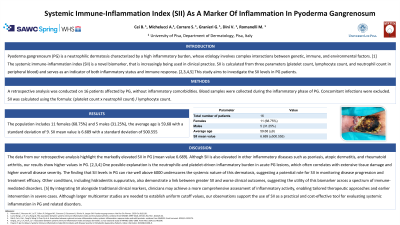Clinical Research
(CR-011 (RPT-006)) Systemic Immune-inflammation Index (SII) as a Marker of Inflammation in Pyoderma Gangrenosum

The systemic immune-inflammation index (SII) is a novel inflammation biomarker, increasingly applied in clinical practice. SII is calculated based on three parameters (platelet count, lymphocyte count, and neutrophil count in peripheral blood) and serves as an indicator of both inflammatory status and immune response. Pyoderma gangrenosum (PG) is a neutrophilic dermatosis characterized by a high inflammatory burden, with its etiology involving complex interactions among genetic, immune, and environmental factors. This study aims to investigate the SII levels in PG patients.
Methods: A retrospective analysis was conducted on 16 patients diagnosed with PG. Blood samples were collected from all patients. Lymphocyte, neutrophil, monocyte, and platelet counts were measured as x10^3 cells/µL, and the SII was calculated using the formula: (platelet count x neutrophil count) / lymphocyte count.
Results: The population includes 16 patients: 11 females (68.75%) and 5 males (31.25%), the average age is 59,68 with a standard deviation of 9. SII medium value is 6.689 with a standard deviation of 500.555.
Discussion:
SII values in patients with PG were higher than those typically observed in other chronic inflammatory skin diseases. The consistently elevated SII levels in PG highlight the potential for establishing a clinical cut-off value, which could aid in monitoring disease progression and tailoring treatment strategies. Further studies with larger cohorts are warranted to validate these results and determine a precise SII threshold for clinical application.

.jpg)
